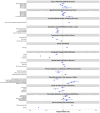Association Between Patient-Level Factors and Positive Treatment Response Among Individuals With a Psychostimulant Use Disorder: A Cross-Sectional Study
- PMID: 39420915
- PMCID: PMC11483802
- DOI: 10.1177/29768357241274483
Association Between Patient-Level Factors and Positive Treatment Response Among Individuals With a Psychostimulant Use Disorder: A Cross-Sectional Study
Abstract
Objectives: The purpose of this study was to provide insights into which patient-level characteristics are associated with a positive treatment response among patients whose primary drug of choice was a psychostimulant with a particular emphasis on understanding the impact of age at first use and co-occurring psychiatric comorbidities.
Methods: We used a cross-sectional study design and the 2019 US Treatment Episode Data Set: Discharges (n = 167 802) to identify outpatient treatment episodes for which the primary drug of choice was a psychostimulant. We defined a positive treatment response as (1) a reduction in drug use between treatment admission and discharge or (2) no use at both admission and discharge. Multivariable logistic regression was conducted, overall and stratified by presence of psychiatric comorbidity, to identify demographic, clinical, and treatment-level factors associated with positive treatment response.
Results: Treatment episodes among patients 11 years and under at the time of first use had a 22% higher odds of having a positive response to treatment as compared to those treatment episodes in which the person was 30 years or older at the time of first use. The presence of psychiatric comorbidity resulted in substantial differences in direction and magnitude of the relationships between treatment response and covariates. Positive response to treatment was less likely for episodes among Non-Hispanic Black/African American persons, in detoxification settings, for unemployed individuals, or for individuals living in the South, but a positive response was more likely for episodes occurring in rehabilitation/residential settings.
Conclusions: Race/ethnicity, geographic region, treatment setting, and employment status were the strongest predictors of response to treatment. Treatment programs should maximize treatment of psychiatric conditions, intensify support for persons of color seeking treatment in detoxification settings, and increase efforts to find adequate employment for patients.
Keywords: Psychostimulants; addiction; age at first use; psychiatric comorbidity; substance use disorder.
© The Author(s) 2024.
Conflict of interest statement
The author(s) declared no potential conflicts of interest with respect to the research, authorship, and/or publication of this article.
Figures
Similar articles
-
The impact of psychiatric comorbidity on treatment discontinuation among individuals receiving medications for opioid use disorder.Drug Alcohol Depend. 2020 Nov 1;216:108244. doi: 10.1016/j.drugalcdep.2020.108244. Epub 2020 Aug 22. Drug Alcohol Depend. 2020. PMID: 32861134
-
A Post-Hurricane Katrina Examination of Substance Abuse Treatment Discharges With Co-Occurring Psychiatric and Substance Use Disorders.J Dual Diagn. 2017 Apr-Jun;13(2):144-156. doi: 10.1080/15504263.2016.1277816. Epub 2017 Jan 3. J Dual Diagn. 2017. PMID: 28045601
-
The association of psychiatric comorbidity with treatment completion among clients admitted to substance use treatment programs in a U.S. national sample.Drug Alcohol Depend. 2017 Jun 1;175:157-163. doi: 10.1016/j.drugalcdep.2017.02.006. Epub 2017 Apr 19. Drug Alcohol Depend. 2017. PMID: 28432939 Free PMC article.
-
Systematic reviews of the effectiveness of day care for people with severe mental disorders: (1) acute day hospital versus admission; (2) vocational rehabilitation; (3) day hospital versus outpatient care.Health Technol Assess. 2001;5(21):1-75. doi: 10.3310/hta5210. Health Technol Assess. 2001. PMID: 11532238 Review.
-
Prevention of suicide and attempted suicide in Denmark. Epidemiological studies of suicide and intervention studies in selected risk groups.Dan Med Bull. 2007 Nov;54(4):306-69. Dan Med Bull. 2007. PMID: 18208680 Review.
References
-
- National Institute on Drug Abuse. Rising Stimulant Deaths Show That We Face More Than Just an Opioid Crisis. National Institute on Drug Abuse. Published November 12, 2020. Accessed June 27, 2022. https://nida.nih.gov/about-nida/noras-blog/2020/11/rising-stimulant-deat...
-
- NIHCM. Stimulant Deaths on the Rise, Compounded by Rise in Synthetic Opioids. NIHCM. 2021. Accessed June 24, 2022. https://nihcm.org/publications/stimulant-deaths-on-the-rise-compounded-b...
-
- Lipari RN, Ahrnsbrak RD, Pemberton MR, Porter JD. Risk and protective factors and estimates of substance use initiation: results from the 2016 National Survey on Drug Use and Health. In: CBHSQ Data Review. Substance Abuse and Mental Health Services Administration (US); 2012. Accessed October 2, 2023. http://www.ncbi.nlm.nih.gov/books/NBK481723/ - PubMed
Grants and funding
LinkOut - more resources
Full Text Sources


